Mobile GPU Faceoff: AMD Dynamic Switchable Graphics vs. NVIDIA Optimus Technology
by Jarred Walton on September 20, 2011 6:40 AM ESTWhat about Recent Games?
We do have one major concern with AMD’s Dynamic Switchable Graphics that we haven’t really addressed so far: drivers. Why are drivers a problem? Just like AMD’s non-dynamic switchable graphics, you’re stuck waiting for your laptop OEM to release new drivers, as AMD’s mobile reference drivers are only for discrete GPUs (and even then, not all OEMs participate, Sony and Toshiba being two prime examples). The drivers for switchable graphics consist of a proxy driver that intercepts calls and determines which GPU should receive the request, Intel’s IGP driver, and AMD’s GPU driver. AMD informed us that they make a new driver build available on a monthly basis for switchable graphics, but it’s up to the laptop vendors to test and validate the driver (and add in their hooks for keyboard shortcuts like LCD brightness and such) and make it available to the public. Generally speaking, this happens when a laptop is first launched, and if you’re lucky, you might get one or two more driver updates before the OEM stops worrying about an older model laptop.
So how big of a concern is this really? Our selection of gaming benchmarks consists of games that are all six months to more than a year old, so any moderately recent driver should work properly on our test suite. As we’ve already noted, there was a periodic stability issue in DiRT 2 (not consistently reproducible and perhaps related more to the game than AMD’s drivers), and there was a major rendering issue in StarCraft II at medium detail settings or higher. With our current gaming suite experiencing problems, we wanted to look at some newer titles to see if the drivers might have additional issues.
We selected six games that have all come out in the past six months. In alphabetical order, the games are Deus Ex: Human Revolution, DiRT 3, Duke Nukem Forever, Portal 2, Super Street Fighter IV: Arcade Edition, and The Witcher 2—and we’re also tossing in results from Enemy Territory: Quake Wars just for fun (an OpenGL game). Some of these games will become part of our new benchmark suite in a couple months (after Battlefield 3, Rage, and Skyrim launch) while others are recent releases that ought to be moderately demanding. We did run performance tests on all of these games, along with testing for compatibility with the Sony and Acer laptops. First, let’s look at performance, using Medium settings.
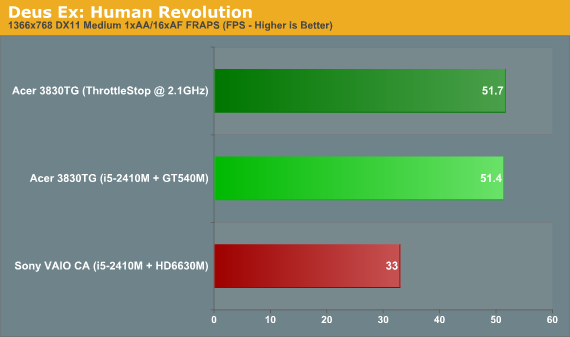
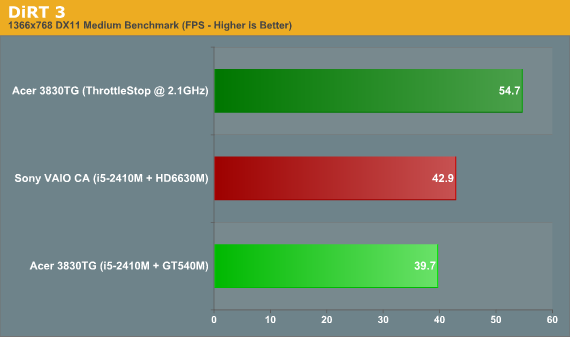
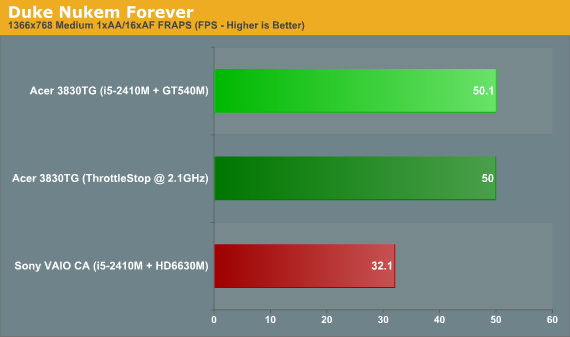
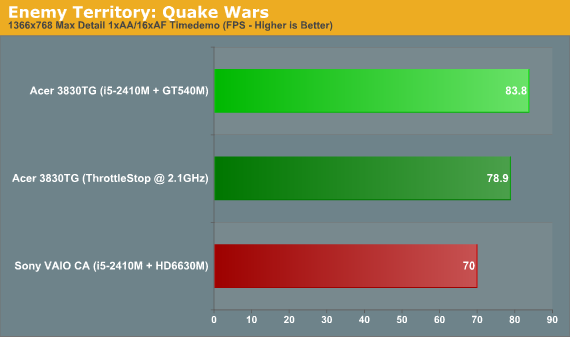
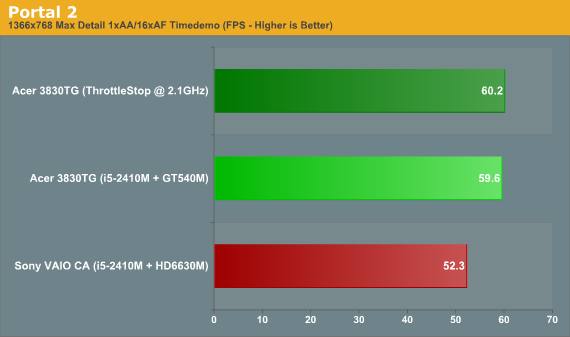
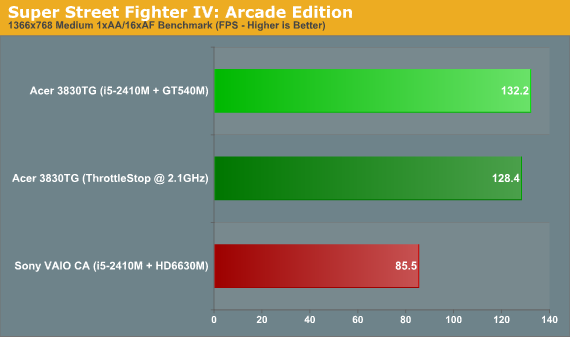
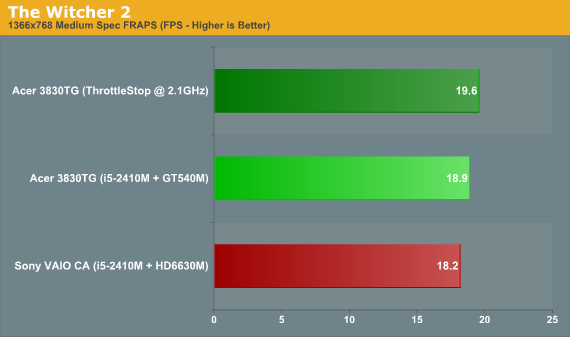
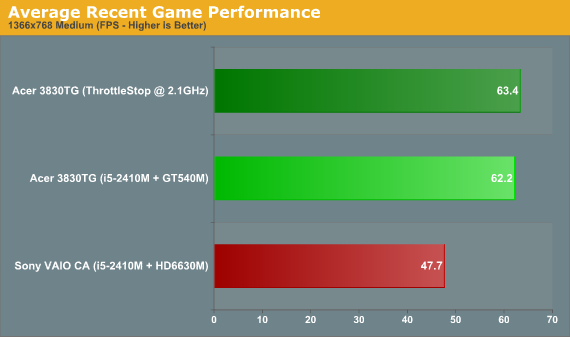
So here’s where things get interesting. In our current (soon to be deprecated) list of games on the previous page, the 6630M in the VAIO C generally equals the GT 540M in the Acer 3830TG. NVIDIA wins in Bad Company 2, Left 4 Dead 2, Mafia II, Mass Effect 2, and STALKER: Call of Pripyat by 4-14%; AMD counters by claiming wins in Civilization V (3%), DiRT 2 (1%), Metro 2033 (6%), StarCraft II (31%), and Total War: Shogun 2 (6%). Obviously, StarCraft II is the big difference, and it looks like the CPU throttling (or using ThrottleStop to set the CPU speed to 2.1GHz) accounts for a large portion of the difference. As we mentioned on the previous page, the Alienware M11x R3 averages out to 3.5% faster than the best the Acer can muster, and the Dell XPS 15 comes in 9% faster than the 3830TG, so if the CPU throttling weren’t present we’d expect the 3830TG to end up around 6% faster than the VAIO CA. Be that as it may, let’s just call it a tie between the GT 540M and HD 6630M and move on to our newer titles.
Looking at the recent releases (along with the OpenGL Enemy Territory: Quake Wars), the tables shift dramatically. The closest the VAIO C/HD 6630M gets is in The Witcher 2, where the Acer 3830TG/GT 540M still has an 8% lead. Elsewhere, NVIDIA leads by over 50% in Deus Ex: Human Revolution, Duke Nukem Forever, and Super Street Fighter IV: Arcade Edition. Rounding things out, DiRT 3 is 28% faster, ETQW is a 20% lead, and Portal 2 is 15% faster. Also worth pointing out is that three of the games in this list (DiRT 3, Deus Ex, and Portal 2) are promoted by AMD (and SSF4 is promoted by NVIDIA). Overall, in our recent titles the Acer leads the Sony by a not-insignificant 35% on average—and that’s with an Optimus laptop that we’re either running at a slower CPU speed, or potentially getting some CPU throttling. How much of the performance loss is caused by unoptimized drivers is unclear, but we suspect the 6630M with Catalyst 11.8 would fare a lot better.










91 Comments
View All Comments
just4U - Tuesday, September 20, 2011 - link
It's been a looong day.. I need a good chuckle.. thanks!inplainview - Wednesday, September 21, 2011 - link
Are you serial stupid? I said above that I do not play games. Are you reading challenged?ggathagan - Wednesday, September 21, 2011 - link
Thanks,I was wondering what you ended up buying.
What're you having for dinner tonight?
Mom was worried, too. You might want to call her.
sonofsanta - Tuesday, September 20, 2011 - link
I, er, I think the phrase you're looking for is "cry foul", not "fowl". Wouldn't make much sense if people started running round shouting "Pheasant!" because nVidia sent you both laptops...MysteriousAndy - Tuesday, September 20, 2011 - link
++http://dictionary.cambridge.org/dictionary/british...
swx2 - Tuesday, September 20, 2011 - link
relevant:http://www.vgcats.com/comics/?strip_id=119
JarredWalton - Tuesday, September 20, 2011 - link
It's simply a typo (or misspelling if you prefer); I'm fully aware that we "cry foul" and not "fowl".beginner99 - Tuesday, September 20, 2011 - link
... makes absolutely no sense."we thought it would be interesting to see just how much performance you give up by gaming with the slower Llano CPU. Ready for some fun? You actually gain 5% performance with the A8-3500M + 6630M compared to the VAIO CA. ...Can you feel my frustration (with Sony) yet?"
The Charts show the i5 being better in every single benchmark especially starcraft 2, 29 vs 62 fps and you claim i5 has a 9% lead? Sorry but in my math its over 100% faster.
Again that last paragraph makes 0 sense and contradicts the data.
JarredWalton - Tuesday, September 20, 2011 - link
Crap... I had the wrong numbers in my spreadsheet. Will update the text, because I was totally flabbergasted by the percentages. Turns out I had numbers from a different laptop listed (but the charts are correct). Thanks for pointing this out!Althernai - Tuesday, September 20, 2011 - link
Actually, HP's dv6t and dv7t have the 6770M with switchable graphics. It was badly broken upon release (dynamic only = OpenGL only on Intel), but HP has since released a BIOS update which allows you to select between Dynamic and Fixed in the BIOS (not in Windows like the Sony, but at least it's possible now).
Updating drivers on the HP dv6t is not so bad: you need to install AMD's drivers on top of what HP provides, but it seems to work OK as long as you leave out the control center. AMD releases two sets of drivers: the normal type which comes with all kinds of restrictions and the "hotfix" type which can be installed on practically anything (including even FirePro GPUs). You can always get the latter for the current month if there is a problem with downloading the driver.